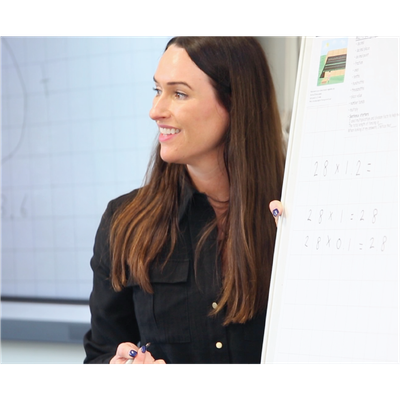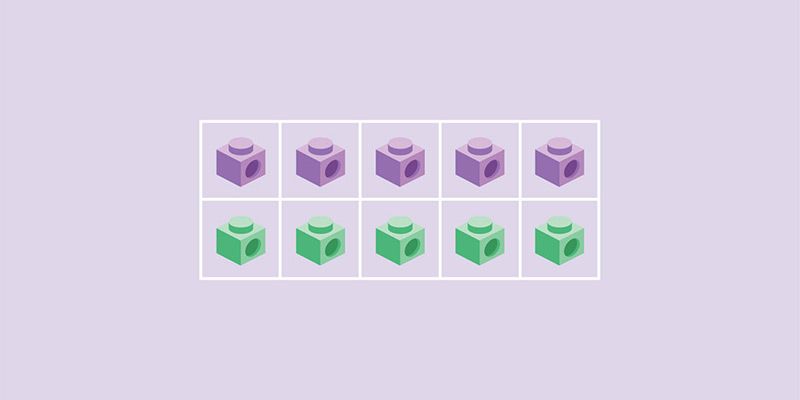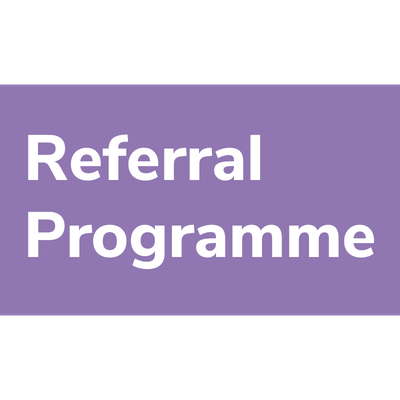Early Years Guide
Introduction
The first few years of a child’s life are especially important for mathematics development. For many education experts, no other group represents a greater opportunity to improve mathematical standards than children in the early years.
The more grounded in mathematical concepts young children become, the better their later outcomes. Conversely, research shows that children who start behind in mathematics tend to stay behind throughout their educational journey.
On this page, we’ll examine:
What do we mean when we talk about Early Years?
The UK government published the Statutory Framework for the early years foundation stage in March 2017. It sets standards for the learning, development and care of children from birth to five years old.
Areas of learning
The EYFS framework outlines seven areas of learning:
- Communication and language
- Physical development
- Personal, social and emotional development
- Literacy
- Mathematics
- Understanding the world
- Expressive art and design
Mathematics in EYFS
In the context of mathematics, the framework says children must be given opportunities to develop their skills in the following areas:
- Counting
- Understanding and using numbers
- Calculating simple addition and subtraction problems
- Describing shapes, spaces, and measure
Revised guidance
The DfE published revised guidance in March 2021 to take effect in September 2021.
The mathematics component now incorporates many elements of the mastery approach.
Specifically, the revised framework says:
Children should be able to count confidently, develop a deep understanding of the numbers to 10, the relationships between them and the patterns within those numbers.
By providing frequent and varied opportunities to build and apply this understanding — such as using manipulatives, including small pebbles and tens frames for organising counting — children will develop a secure base of knowledge and vocabulary from which mastery of mathematics is built.
In addition, it is important that the curriculum includes rich opportunities for children to develop their spatial reasoning skills across all areas of mathematics including shape, space and measures.
It is important that children develop positive attitudes and interests in mathematics, look for patterns and relationships, spot connections, ‘have a go’, talk to adults and peers about what they notice and not be afraid to make mistakes.
Early Learning Goals
The latest framework has the following early learning goals for mathematics:
Number
Children at the expected level of development will:
- Have a deep understanding of number to 10, including the composition of each number
- Subitise (recognise quantities without counting) up to five
- Automatically recall (without reference to rhymes, counting or other aids) number bonds up to five (including subtraction facts) and some number bonds to 10, including double facts
Numerical patterns
Children at the expected level of development will:
- Verbally count beyond 20, recognising the pattern of the counting system
- Compare quantities up to 10 in different contexts, recognising when one quantity is greater than, less than or the same as the other quantity
- Explore and represent patterns within numbers up to 10, including evens and odds, double facts and how quantities can be distributed equally
Reception
Reception class is the first year at primary school in England, generally for children ages four to five. Unlike every other school year, it’s not compulsory for children to attend Reception, though it’s a good way to introduce them to life at school.
Multi-academy trusts
Looking for impactful maths provision across your multi-academy trust?

Learning in the early years
The first few years of a child’s life are especially important for mathematics development , says the National Center for Excellence in the Teaching of Mathematics.
Research shows that early mathematical knowledge predicts later reading ability and general education and social progress.
As young as eight months old, children are developing an awareness of number names, and include these in their speech, as soon as they begin to talk. As children listen to the talk around them, they are introduced to numbers through opportunities that occur in everyday life, and experience a variety of number rhymes. This supports their growing knowledge of number names.
According to the NCETM, there are:
Six key areas of mathematical learning
- Cardinality and counting
- Comparison
- Composition
- Pattern
- Shape and Space
- Measures
Looking briefly at each in turn:
Cardinality and counting
When children understand the cardinality of numbers, they know what the numbers mean in terms of knowing how many things they refer to.
Comparison
Comparing numbers involves knowing which numbers are worth more or less than each other.
Composition
Learning to ‘see’ a whole number and its parts at the same time is a key development in children’s number understanding.
Pattern
Developing an awareness of pattern helps young children to notice and understand mathematical relationships.
Shape and space
Mathematically, the areas of shape and space are about developing visualising skills and understanding relationships, such as the effects of movement and combining shapes
Measures
Measuring in mathematics is based on the idea of using numbers of units in order to compare attributes, such as length or capacity.
Numeracy
Learning to count in the early years is a fundamental skill and key to mastering mathematical concepts in the future, but there’s more to it than you might think, says Sabrina Pinnock, a primary school teacher in Yorkshire.
According to researchers Rochel Gelman and C.R. Gallistel, these are the steps needed to successfully count:
- The one-to-one principle: children must name each object they count and understand there are two groups: the one that has been counted and the one that hasn’t yet been counted
- The stable order principle: children must know how to count in the right order
- The cardinal principle: children need to understand the last number in the set is the total amount
- Counting anything: children need to realise that anything can be counted, not just objects that can be touched, but also things like claps and jumps
- Order of counting doesn’t matter: children need to understand that the order of counting in the set is irrelevant and will still lead to the same amount
Assessing children to find out which step they are struggling with is key to helping them overcome difficulties and become confident counters.

How do children develop counting skills?
Very young children start to count spontaneously and later begin to refine their skills by pointing their finger at the objects they are counting.
They will often try to get all the names of the numbers they know into their count as they pass their finger along the objects. They also reuse numbers. If they have not finished and they have used up all their known numbers, they will begin using the same numbers again. For example, a child might decide to count eight shells she collects at the beach. She might line them up carefully, tag numbers to them by pointing as she slides her finger along the shells, quickly counting out loud, “one, two, three, four, five, one, two, three, four, five, one, two, three.”
In their drive to make meaning, children are eager to experiment as they acquire new small bits of mathematical knowledge. It is extremely important to respect their developing understanding and not expect “perfect” counting sequences.
By valuing children’s partial understanding, children will develop enthusiasm for numbers and become confident mathematicians.
Activities to boost number sense in Reception Year
Children need lots of opportunities to develop number sense and deepen their conceptual understanding. Here are some simple activities to get your Reception Year learners counting:
Crowd control
Display the number of children allowed in each area using pictorial representations of cubes on a 10 frame. Once the children begin to realise how many are allowed in the area, they start to discuss the meaning of more and less. For example, “no more children are allowed in,” or “you can come in because one more than three is four.”
Bunny ears
Encourage children to show numbers using their fingers above their head. “Bunny ears six” means they place their fingers above their head to show six. They may decide to use three fingers on each hand. As they become more confident, you could introduce swapping, where they show the same number but with a different configuration of fingers, in this case two and four, or five and one.
Grouping straws
Each morning, drop different amounts of art straws all over the carpet. Say something like, �“oh no class, I can’t believe it. I’ve dropped all my straws again. They were all in 10s. Can you help me?” This activity helps children consolidate counting objects and gets them to think about stopping after they have made 10. Providing elastic bands helps them to keep track of their groups of 10.
Fastest 10 frames
This game can help distinguish between those who have developed a good understanding of number sense and those who need further support. Give each child their own frame and cubes. Tell them a number and observe how they place the cubes on the frame. If the children are working with the number eight, do they say each number name as they place the cube on the frame, or do they realise eight is two less than 10? If so, they should be able to place the cubes down faster than other children.
What do they do when you say the next number? For example, for the number five, do they automatically remove three cubes, or do they remove all of the cubes and start over counting from one to five?
Everyday questions to develop number sense
These questions for children aged five to six help develop their number sense and let them practice using mathematical terms.
When prepping lunch or a snack, count out the different types of food with your child, and as you lay the table, count out the different items. Ask your child questions like:
- How many grapes are there?
- How many tomatoes are there?
- How many plates are there?
Practice using the terms more than, fewer than and as many as by asking:
- Are there more grapes than tomatoes?
- Are there fewer tomatoes than grapes?
- Are there as many plates as people eating?
Remember to practice each sentence:
- There are more grapes than tomatoes
- There are fewer tomatoes than grapes
- There are as many plates as family members eating
When counting, make sure that you count one number for one item to strengthen your child’s sense of one-to-one correspondence.
Number Rhymes
Carefully select number rhymes to include those that children are familiar with from home. Make sure the rhymes include:
- Counting back and counting forward
- “No” or “none” (Five little ducks went swimming one day)
- Counting in pairs (two, four, six, eight, Mary at the cottage gate)
- Counting to five, 10 and beyond
Problem solving, reasoning and numeracy
The EYFS requires children to be supported in developing their understanding of problem solving, reasoning and numeracy in a broad range of contexts in which they can explore, enjoy, learn, practise and talk about their developing understanding. They must be provided with opportunities to practise these skills and gain confidence.
Young children learn best through play. For their learning to be effective, they need sensitive and informed support from adults.
All children can be successful with mathematics, provided they have opportunities to explore ideas in ways that make personal sense to them and opportunities to develop concepts and understanding. Children need to know that practitioners are interested in their thinking and respect their ideas.
Foundations
Maths — No Problem! Foundations is designed with all the theory and rigor that underpins a true mastery approach. It meets all the requirements of the national curriculum’s Early Years Foundation Stage. But Maths — No Problem! Foundations doesn’t shy away from embedding learning through play in Reception.
Genuine learning through play in the early years is something the team at Maths — No Problem! gets very excited about. What may appear to be simple games are actually carefully designed activities that have a deep maths mastery focus.
Maths — No Problem! Foundations is a complete Reception programme that includes Workbook Journals, Picture Books, and online Teacher Guides with printable resource sheets, all in one package.
The Maths — No Problem! suite of products — including textbooks, workbooks, a revolutionary online assessment tool, world-class teacher training, and much more — is based on the Singapore method, which combines 30 years of international research with painstaking craftsmanship and constant refinement.
Mark making
Research from Carruthers and Worthington into children’s mathematical graphics reveals young children use their own marks and representations to explore and communicate their mathematical thinking. These graphics include:
- Scribble-marks
- Drawings
- Writing
- Tally-type marks
- Invented and standard symbols including numerals
Young children’s graphical exploration “builds on what they already know about marks and symbols and lays the foundations for understanding mathematical symbols and later use of standard forms of written mathematics,” the researchers said.
In a 2009 publication, the UK Department for Children, Schools and Families, says practitioners should: “Value children’s own graphic and practical explorations of problem solving” and observe “the context in which young children use their own graphics.”
Developing understanding with careful questioning
When children play and interact with other children, there are always opportunities for maths talk to help them develop a deep understanding, says Sabinra Pinnock.
For instance:
- I have made a pattern. What’s your pattern?
- How many blocks taller is my model compared to yours?
- How do we know this area is full?
- I have three cars, how many do you have?
- Do you have more?
- How do you know?
Give learners long enough to think about their answer and give their response, but not so long that it disrupts the flow of play.
Adding maths talk activities to your daily routine
Developing maths talk in your daily routine gives learners a chance to understand concepts while using real-life concepts. It also means that children can consolidate what they have learned.
The following activities can get you started:
How many children are at school?
Get your class to work out how many children are at school by placing a picture of themselves or a counter representation on large 10 frames. Ask them questions like:
- How do we know this 10 frame is full?
- How many children are absent?
- How do you know?
- What can you tell me about number seven?
Sorting and grouping objects as a class
Sorting and grouping objects as a class helps children learn to reason and look for patterns. Give them a variety of buttons each day and ask open-ended questions like, “how can we sort the buttons?” They can use critical-thinking skills to come up with a range of ideas like sorting by size, colour, pattern, and shape.
Vote for a story
First, ask a child to pick two books. Everyone in the class gets to vote (using a piece of lego, for instance) on which of the books should be read. Tally the votes at the end of the day to determine the winner. This can lead to questions such as:
- Why?
- How do you know?
- How many more votes did one book have than the other?
The key to introducing mastery in the early years is to keep activities fun and part of your daily routine. The more learners explore maths through play, the more engaged they become.
Pattern Awareness
Dr. Sue Gifford, emeritus fellow at University of Roehampton, says recent research shows a child’s ability to spot mathematical patterns can predict later mathematical achievement, more so than other abilities such as counting. It also shows pattern awareness can vary a great deal between individuals.
Australian researchers, Papic, Mulligan and Mitchelmore have found pattern awareness can be taught effectively to preschoolers, with positive effects on their later number understanding.
Explicitly teaching pattern awareness links to encouraging “pattern sniffing” with older children in order to develop mathematical understanding and thinking.
What is mathematical pattern awareness?
Patterns are basically relationships with some kind of regularity between the elements. In the early years, Papic et al suggest there are three main kinds:
- Shapes with regular features, such as a square or triangles with equal sides and angles, and shapes made with some equally spaced dots
- A repeated sequence: the most common examples are AB sequences, like a red, blue, red blue pattern with cubes. More challenging are ABC or ABB patterns with repeating units like red, green, blue or red, blue, blue
- a growing pattern, such as a staircase with equal steps
Children who are highly pattern aware can spot this kind of regularity: they can reproduce patterns and predict how they will continue.
Why is pattern awareness important?
Spotting underlying patterns is important for identifying many different kinds of mathematical relationships. It underpins memorization of the counting sequence and understanding number operations, for instance recognizing that if you add numbers in a different order their total stays the same.
Pattern awareness has been described as early algebraic thinking, which involves:
- Noticing mathematical features
- Identifying the relationship between elements
- Observing regularities
The activity Pattern Making focuses on repeating patterns and suggests some engaging ways of developing pattern awareness, with prompts for considering children’s responses. Children can make trains with assorted toys, make patterns with twigs and leaves outside or create printing and sticking patterns in design activities.
Repeating Patterns
It is important to introduce children to a variety of repeating patterns, progressing from ABC and ABB to ABBC.
Focusing on alternating AB patterns can result in some young children thinking that ‘blue, red, red’ can’t make a pattern. They say things like, “That’s not a pattern, because you can’t have two of the same colour next to each other.”

Cognitive Load Theory
Cognitive Load Theory has gained a lot of traction in recent years as educators embrace evidence-based research to inform their evolving practice, says Ross Deans, a KS2 teacher and maths lead in Bournemouth, England.
What is Cognitive Load Theory and why is it important?
Why are new teachers so overwhelmed by tasks that more experienced teachers can juggle alongside multiple other responsibilities?
The answer is simple — new skills demand more attention.
This logic can be applied to any situation. When learning to drive, for example, you focus carefully on every small detail. That mental exertion can be very demanding. Compare that to the feeling of driving after you’ve been doing it for years; you may barely remember the drive, the process is so familiar.
Now put yourself in the shoes of your pupils. Each lesson provides fresh learning and new skills to master. Consider what happens inside your learners’ heads when they encounter new information, new skills and new vocabulary.

Working memory
Cognitive Load Theory, originated by John Sweller, acknowledges that working memory is very limited.
Working memory is the information we hold in our minds while we’re learning. The number of things that we can keep in working memory at one time is approximately four, plus or minus one, and perhaps even less for children.
It’s important to keep this in mind when planning and delivering lessons. If our learners cannot balance more than four things in their working memory, then we need to be very careful about the information we choose to present to them.
Intrinsic versus extraneous load
Intrinsic load includes anything that is necessary to learn a desired skill. In other words, the essential stuff.
Extraneous load is anything that will detract from desired learning. In other words, the stuff that should be reduced as much as possible.
It can be tempting while teaching to embellish lessons with child-friendly imagery and gimmicks. While It’s important to foster enjoyment, we should avoid distracting learners from the essential components of a lesson.
Supporting the transition to long-term memory
While acknowledging the impact of Cognitive Load Theory, we can consider the following to support our learners:
Focused learning objective
First and foremost, we must have a very clear idea of what we want our learners to achieve. Keep the limitations of the working memory in mind and let this guide the content you choose to include in a lesson.
Activate prior learning
At the start of the lesson, you may choose to design a task that encourages learners to retrieve essential skills. This means their working memory can hold on to new learning during the lesson.
Present information clearly
Take time when designing lessons to make sure information is presented clearly. Avoid unnecessary extras which may detract from the learning goal. Keep slides clean and similar in style.
Avoid cognitive overload
In maths, problems are often detailed and complex. Consider breaking questions up into chunks so that learners can digest each part separately. By taking away the final question, you can make a maths problem goal-free.
Maths mastery for Early Years
Given the importance of developing sound mathematical understanding in the early years, the maths mastery approach can be especially useful, considering its focus on problem solving and whole-class learning.

Early Years and CPA
If you’re teaching the Concrete, Pictorial, Abstract (CPA) approach in the early years, it’s best to focus on C and P. Here’s how to use concrete and pictorial representations effectively.
The CPA model works brilliantly in the primary years but for the youngest learners, moving onto abstract concepts too soon causes difficulties. Spending as much time as possible with concrete objects and pictorial representations helps children master number skills.
By the time they reach Key Stage 2, children need to develop their understanding of numbers by being able to visualise what the concrete looks like in their heads. Therefore, it’s positive that the revised EYFS framework focuses on numbers just to 10, from 20 previously.
If learners develop a deep understanding of numbers to 10, their chances of understanding larger numbers increases significantly.
C is for concrete
Concrete is the “doing” stage. During this stage, students use concrete objects to model problems. Unlike traditional maths teaching methods where teachers demonstrate how to solve a problem, the CPA approach brings concepts to life by allowing children to experience and handle physical (concrete) objects.
Spending time with real-life objects
The theorist Jerome Bruner stresses the importance of children spending time learning maths through tangible items. Spending lots of time using real-life objects, solving real-life problems, and manipulating abstract concrete objects (when ready) such as cubes and counters is essential in the early years.
Ideas include counting out fruit for snack time, comparing, sorting and counting a range of different buttons, pasta, and even ‘magic beans’ linked to specific topics.
Early years and number bonds
By mastering number bonds early on, pupils build the foundations needed for subsequent learning and are better equipped to develop mental strategies and mathematical fluency. By building a strong number sense, pupils can decide what action to take when trying to solve problems in their head.
How to teach number bonds
Children are usually introduced to number bonds through the Concrete, Pictorial, Abstract approach. Here’s just one way to introduce and teach number bonds.
Concrete step
Children start out by counting familiar real-world objects that they can interact with. They then use counters to represent the real-world objects. From here, they progress to grouping counters into two groups.
By putting five counters into two groups, children learn the different ways that five can be made. For example, 3 and 2 as illustrated below. With further exploration, children work out other ways to break numbers into two groups.
Pictorial step
Now that they understand the concept with hands-on objects and experience, children progress to writing number bonds in workbooks or on whiteboards. Early number bond explorations might simply reflect the two groups of counters that they created during the concrete step, along with other combinations.
Abstract step
With the concrete and pictorial steps done and dusted, children progress to representing abstract problems using mathematical notation (for example, 3 + 2 = 5).
Early Years and place value
Number and place value are foundational concepts for all mathematics learning. This means we need to address how to teach place value as early as possible so that pupils can secure their knowledge of the concept.
How do you develop an early understanding of place value in the primary school classroom? Let’s start by defining place value. It is a system for writing numerals where the position of each digit determines its value. Each value is a multiple of a common base of 10 in our decimal system.
Here are some teaching strategies I’ve found useful when helping learners develop an early understanding of place value.
Progress through concepts systematically
Developing an understanding of place value requires systematic progression. Each new concept should build on previous learning experiences so that pupils can gain deeper, relational understanding as they go.
This approach ensures knowledge is developed, refined and applied correctly as numbers become meaningful tools for solving problems rather than just a series of symbols on a page. Most importantly, this starts our learners on the path to becoming confident problem solvers and pattern spotters.
Use the CPA approach to establish meaning
The CPA (Concrete, Pictorial, Abstract) approach helps pupils connect a physical representation of a number (concrete manipulatives) to that same quantity as shown in drawings or graphics (pictorial), and finally to the actual written name and symbol for that number (abstract).
Concrete resources are meaning makers. They add meaning to abstract representations of numbers so that when learners progress to the abstract phase, they know what those numbers stand for, what they mean, and how they relate to each other.
If a pupil can identify the meaning of each component in a problem, they are far more confident in how they work to solve it.
Teach the ‘10-ness of 10’
At an early level, spend as much time as possible studying the numbers from 0 to 10, as understanding the 10-ness of 10 is crucial for maths attainment, and it cannot be rushed.
Once this understanding is locked-in, follow this with an introduction to number bonds. Start with the additive relationships between numbers less than 10, then progress to adding and subtracting up to 10. This ensures that learners see 10 as an important ‘base’ number in all of their future maths applications.
Progress to 20, then to 40
I make sure to take my time teaching 10 and teen numbers so that a solid understanding of place value with numbers up to 20 is properly established.
I then extend the place value concept by working with numbers up to 40 — followed by addition and subtraction to 40.
Because pupils have learned to make 10 and use number bonds, they are ready to begin working with multi-digit numbers and regrouping. Focusing on numbers to 40 while developing the concept of place value also allows learners to associate numbers with easily-managed, physical quantities (meaning makers).
Use base 10 blocks for 100 and 1000
The work we’ve done building a gradual understanding of place value will have prepared pupils to progress to three-digit numbers. So we can now move on to studying up to 100.
We start here by developing an understanding of numbers in multiple place value representations. For example, one thousand five hundred is 15 hundreds or 150 tens.
Once they get the hang of that, learners then sharpen their counting, reading, and writing skills for numbers up to 1,000. Moving into addition and subtraction with numbers up to 1,000 — with and without regrouping — is the next step.
Here is where our work establishing an early understanding of place value is key, because pupils will intrinsically know why these algorithms work for three and four-digit numbers. Base 10 blocks are a great tool to help solidify those earlier place value ideas when working with numbers up to the thousands.
Approach larger numbers the same way
The CPA approach is once again our answer to learning place value in larger numbers. Apply those skills and always be on the lookout for chances to extend number and place value concepts.
For example, you can identify and complete number patterns or find missing digits on a number line.
From there you can explore strategies for mental mathematics as well as addition and subtraction for numbers up to 10,000. Take learners even deeper by having them explore place value with an emphasis on multiplication, division, and decimals.
Mastering maths concepts like place value in the early years is not just key to success in the classroom. It prepares learners for a lifetime of deep mathematical understanding by giving them invaluable real-world tools like resilience and problem-solving ability.
And a confident problem solver in maths is a confident problem solver in life.
Conclusion
Well done on making it to the end of our Ultimate Guide to Early Years.
We’ve looked at the definition of Early Years and what the government recommends in its revised guidance, and we’ve taken a deep dive into some of the most-effective strategies for teaching mathematics mastery in the Early Years.
We’ve also discussed Cognitive Load Theory and what it means for teachers in the Early Years classroom.
If you’d like to learn more about Early Years, we recommend checking out the following links:
- NCETM: How Early Years children develop mathematical thinking (Podcast)
- NRICH: Early Years Foundation Stage Homepage
- The School of School: Episode 17 Play and early years (Podcast)
- Maths — No Problem! CPA approach
Also, don�’t miss our other Ultimate Guides:
Share your success, be rewarded
Everyone needs a break. Especially the kids that are missing out.
